(九年级英语教案)句子的结构
- 格式:docx
- 大小:20.17 KB
- 文档页数:11

九年级英语教案及课后反思九年级英语教案及课后反思1一.教学目标:1. 语言知识目标:1)掌握本单元基础知识,掌握过去完成时的结构和用法。
2)能根据所学知识进行写作,提升学生的写作能力。
2. 情感态度价值观目标:二.教学重难点过去完成时的用法三.教学过程Ⅰ. Warming up and revision1. Have adictationof the new words and expressions this unit.2. Retellthestories of April Fool’s Day .根据句意,用括号内所给动词的适当形式填空。
1) By the endoflast year, I ___________ (be) to the West Hill Farm three times.2) By the time Igotup, Mom _________ (go) out for some exercise.3)I______________(learn) 1,000 English words by last term.4) By 9 o’c locklastnight, we __________ (get) 200 pictures from the spaceship.5) When I wentintothe classroom, the final bell ___________ (ring). I was happy that Iwasn’tlate.Keys: hadbeenhadgonehad learnedhad gottenhad rung根据句意和汉语提示,填写恰当的短语完成下列句子。
1) He ___________(醒来) very early and went out for a walk inthepark.2) I______________(让她搭便车), so she invitedme to have dinner.3) I hope thatallof you will come to the meeting ____________ (准时).4) Hiscar___________ (出故障), so he had to getit repaired.5) This Mondaymyalarm clock didn’t __________ (发出响声) and I got uplate.Keys: woke up gave her a lifton timebroke downgo offⅡ. Lead-inDo you haveanyexperience on April Fool’s day? Now can youremember a lucky or an unlucky day?What happened? Make some notes about whatyou remember.III. Practice.1. Work on 3a.Makenotes.Can you rememberalucky or an unlucky day? What happened? Make some notes about whatyouremember.What was thedate?What happenedfirst?Was this luckyorunlucky? Why?Whathappenednext?How did thedayend?How did youfeelabout this day?2. Share yourideaswith others in class.IV. Writing1. Write astoryabout your lucky or unlucky day and tell your story to a partner or e your notes to write a story about your lucky or unlucky day.写作指导:常见的表达句型:My lucky/unlucky dayI willalwaysremember the date…This wastheluckiest /unluckiest day of my life…When I woke upthatmorning…Later that day…I couldn’tbelieve…Then/After that…Finally…I think….What alucky/anunlucky day!2. Ask Ss to writeapassage in class.3. Tell yourstoryto your partner or the class.Example:My lucky dayI willalwaysremember the date –April Fool’s Day last year.This wastheluckiest day of my life.When I woke upthatmorning, I brushed my teeth, washed my face, then I read English for halfanhour. It was time to eat my breakfast. My little brother gave me a pieceofOreo. I was very glad to eat it first. Then I felt strange. It tastedspecial.What was it? I looked at my little brother. He laughed loudly and saidnothing.Later that day,Iknew he put toothpaste (牙膏) into the Oreo. Icouldn’t believe I wasfooled by him. I brushed my teethagain. After that, my brother gave me a box ofOreo, and said “Happy April Fool’s Day.”Finally I washappyto get these delicious biscuits.I think I hadahappy and lucky day.What a lucky day!V. Self-check.Work on SelfCheck1:1. Let some Ssreadthe words in the box. Make sure all the Ss know the meaning of the words.2. Let Ss readthesentences in Self check 1. Then Ss try to fill in the blanks with thecorrectforms of the words in the box.cancelmiss west accidentladyofficermarketunexpectedLast Saturdayaftermy French course, I decided to drive to the ________ to buy a meat piefordinner. As I was heading ________, I saw a huge truck in the middle of theroad.There had beena(n)_________ and there were many police _______ around. I turned around anddecidedto go to a nearby mall.However, I________the road that led to the mall. Then I saw a restaurant that soldchickennoodles. I went inside and the _____, who was the owner, served me themostdelicious bowl of chicken noodles ever. I had made a(n)____________discovery!I’mso glad that I _________ my plan to go to the market.1. Letsome Ss read their answers. Check theanswers with the Ss.Keys: market west accident officersmissedlady unexpected canceledWork on Self check21. Tell Ss thattheyhave to fill in the blanks with Past Perfect Tense. More than one answersmay bepossible.2. Ss think andtryto complete the sentences by themselves.3. Let some Ssreadtheir answers to the class.4. Sharetheiranswers together.e.g.1) A: Why didn’tyouhand in your science homework?B: Before Icould start working on it, mybaby brother started crying and I had to lookafter him as my mother was sick.2) A: Why didn’tyoutake a shower this morning?B: By the time Igotup, my sister had already gone into the bathroom and the bus was honkingfor meto hurry up.3) A: Why didyou have to walk home from school?B: By the timeIleft my school, the school bus had already left.VI. Exercise1. We ______fourthousand new words by the end of last year.A. learnedB.had learnedC. have learnedD.willlearn2. He told usthathe ______ the letters in the morning.A. willpostB.havepostedC. waspostingD. had posted3. —Did you seeMr Smith when you were in France?—No. When I_______ France, he _______ to China.A. had arrivedin;had goneB. arrived in;hasbeenC. got to;hadgoneD. had got to;hadbeenVII. Homework1. 复习本单元内容。

人教版义务教育教科书◎英语九年级全一册Unit 4 I used to be afraid of the dark教材解读本单元话题涉及谈论过去的性格、外貌、特点及喜好等,借此学习used to…这一特有的用来表述过去经历和习惯的语言结构。
Section A 通过对人物性格特点和相貌的今昔对比让学生感知语言内容的结构特征,体会其用法;Section B 部分在Section A的基础上进行延伸和拓展,由描述人物性格、外貌变化向讨论人物行为习惯、爱好的改变,从语言角度上来说,复习巩固了有关行为习惯和爱好的短语,同时通过语篇呈现了其他词汇,阅读部分介绍了一位乡村少年的成长故事,题材发人深省,能激发学生们的关爱之心,起到了情感教育的目的,总之通过本单元的学习,学生的综合能力会得以很大的提升。
单元目标一、知识与技能1. 掌握重点词汇和短语:humorous,silent,helpful,private,European,African,proud,absent,general,score,background,pride,introduction,etc.2. 能正确使用used to do 结构描述或询问过去的情况。
3. 培养听、说、读、写各项基本技能同时注重培养在语境中猜测词意的能力。
二、过程与方法采用直观教学法、情景教学法、讨论、角色表演等方法,学习知识,培养能力,养成好习惯。
三、情感、态度与价值观通过本单元的学习,让学生关注自我发展和自我完善的重要性;同时唤起学生的关爱之心,让他们懂得亲情的可贵。
教法导航采用直观教学法,情景教学法,遵循以学生为主体的原则。
学法导航采用自主学习、小组合作、分角色表演等学习策略。
课时支配第1课时:Section A 1a-2d第2课时:Section A 3a-4c第3课时:Section B 1a-2f第4课时:Section B 3a-Self Check教师备课系统──多媒体教案课时教案第1课时Section A 1a-2d教学目标一、知识与技能1. 能掌握以下单词和短语:humorous,silent,helpful,from time to time,score2. 能掌握以下句型Paula used to be really quiet.---Did Mario use to be short? ---Yes, he did.---What’s he like now? ---He’s tall now.3. 能够用英语描述自己或他人过去常常做的事情;发现自己或他人在外表、性格、兴趣等方面所发生的变化。
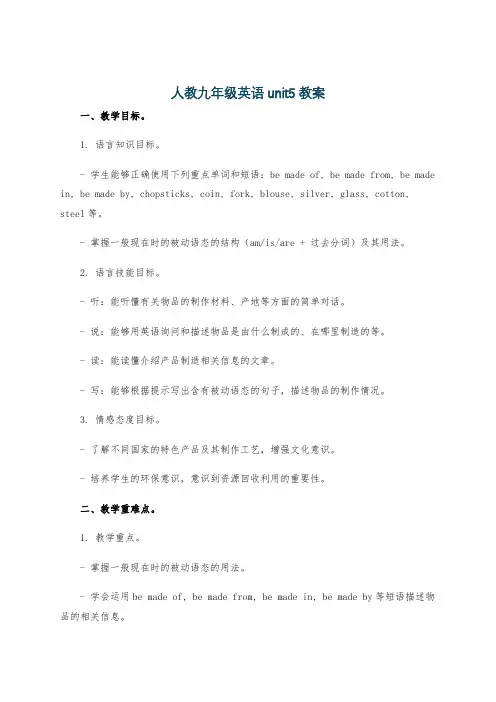
人教九年级英语unit5教案一、教学目标。
1. 语言知识目标。
- 学生能够正确使用下列重点单词和短语:be made of, be made from, be made in, be made by, chopsticks, coin, fork, blouse, silver, glass, cotton,steel等。
- 掌握一般现在时的被动语态的结构(am/is/are + 过去分词)及其用法。
2. 语言技能目标。
- 听:能听懂有关物品的制作材料、产地等方面的简单对话。
- 说:能够用英语询问和描述物品是由什么制成的、在哪里制造的等。
- 读:能读懂介绍产品制造相关信息的文章。
- 写:能够根据提示写出含有被动语态的句子,描述物品的制作情况。
3. 情感态度目标。
- 了解不同国家的特色产品及其制作工艺,增强文化意识。
- 培养学生的环保意识,意识到资源回收利用的重要性。
二、教学重难点。
1. 教学重点。
- 掌握一般现在时的被动语态的用法。
- 学会运用be made of, be made from, be made in, be made by等短语描述物品的相关信息。
2. 教学难点。
- 区分be made of和be made from的用法差异。
- 正确运用一般现在时的被动语态进行书面表达。
三、教学方法。
1. 情景教学法。
通过创设各种与物品制作相关的情景,让学生在真实的语境中学习和运用英语。
2. 任务驱动法。
布置各种任务,如小组讨论、角色扮演、调查等,让学生在完成任务的过程中提高语言综合运用能力。
3. 直观教学法。
运用图片、实物等直观教具,帮助学生更好地理解和记忆单词和短语。
四、教学过程。
(一)导入(5分钟)1. 展示一些常见物品的图片,如筷子、硬币、衬衫等,问学生:“What can you see in the pictures?”引导学生说出这些物品的英文名称。
2. 然后拿出一个用竹子做的筷子和一个用金属做的硬币,问学生:“What are they made of?”引出本节课的重点短语be made of。

英语宾语从句和定语从句教学设计一:教学内容:宾语从句的定义和结构、引导词、语序和时态定语从句的关系代词 that, which, who ,whom,whose二:学情分析:九年级学生的英语水平参差不齐,成绩好的学生能够很好的掌握各个知识点,成绩中等的学生对于有些知识点可能是模糊不清,成绩不好的学生对英语可能完全是一窍不通。
此次宾语从句和定语从句的专项复习,很多学生对两种从句认识不清,对他们应遵守的语法规则认识模糊,直接影响学生的理解句子的能力,尽管宾语从句和定语从句的考核只有两分,但它们涉及的面是广泛的。
因此,我对这两种从句进行了详细的分析并通过历年各市的中考题来加深学生的印象。
三、教学目标知识与技能:复习宾语从句的定义和结构、引导词、语序,掌握时态的变化以及定语从句的定义、结构和关系代词。
过程与方法:通过课堂活动,熟悉话题进行简单的交流,从历年中考题目中找出有关的信息,理解题意,并能简单归纳知识点。
情感态度价值观:通过课堂探究培养学生积极思考,踊跃发言的能力,增强他们解决问题的决心,提高学习英语的兴趣。
四、教学重点、难点:重点:宾语从句的语序;定语从句的关系代词:that,which,who,whom,whose的使用。
难点:宾语从句中,主句与从句在时态上的相互呼应;定语从句中关系代词的使用五、教具:PPT课件、资料六、教学过程:Step1、进行中考考情考点分析分析:岳阳中考题型2016,2018年考的特殊疑问词引导的宾语从句, 2017,2019年考的是定语从句.2019年湖南省有5个市考了定语从句,6个市考了宾语从句,而且都是由特殊疑问词引导的宾语从句。
所考题型都以单项选择题为主。
Step2、板书一些宾语从句和定语从句,让学生分析它们的相同之处以及不同之处,然后老师进行总结。
I heard (that ) he got into a good high school last year.I like music that sounds good.This is the most interesting book (that) I have ever read.Could you tell me who he talked to just now?Tom prefers the singers who write their own songs.Do you know which city he has been to?She has many beautiful skirts which were given by her friends.宾语从句和定语从句的相同之处:都能用that, who,whom,whose,which,why,when where连接句子。

Unit 5 What are the shirts made of? 类别课程标准要求掌握的项目单元话题In this unit, students learn to talk about what products are made of and wherethey are made.单元语法Passive voice (present tense)教学目标 1.能够用英语描述及询问物品的制作材料。
2.正确理解被动语态的用法及句子结构。
3.了解一些日常用品的制成材料,增加生活常识,养成良好的生活习惯;了解一些地方知名产品或传统艺术品的制作过程以及制作材料,培养学生的民族自豪感及爱国主义精神等素养。
学情分析本单元通过了解中国制造的产品在全世界的影响力,让学生树立强烈的民族自豪感。
让学生通过梳理句子主语与谓语的关系,与主动语态的对比,体会被动语态谓语动词结构的变化。
在实际运用中熟练掌握被动语态。
第一课时Section A(1a~2d)教学设计知识目标类别课时要点重点单词1.produce v. 生产,制造2.widely adv. 广泛地,普遍地3.process v. 加工,处理4.pack v. 包装,装箱5.leaf n.叶,叶子重点词组 1.be made of/from 由……制成课堂环节§自主学习案翻译下列词组。
1.由……做成 be__made__of/be__made__from2.在某地制造 be__made__in__3.艺术和科学展览 the__art__and__science__fair4.飞机模型 a__model__plane5.因……出名 be__famous__for/be__known__for6.在山边上 on__the__sides__of__mountains7.手工制作 by__hand8.世界各地 all__over__the__world9.对……有好处 be__good__for10.在过去 in__the__past11.据我所知 as__far__as__I__know§课堂导学案Step 1 准备与热身(Preparation)播放动画片《造纸过程》的视频,让学生们了解这个中国传统发明的情况。
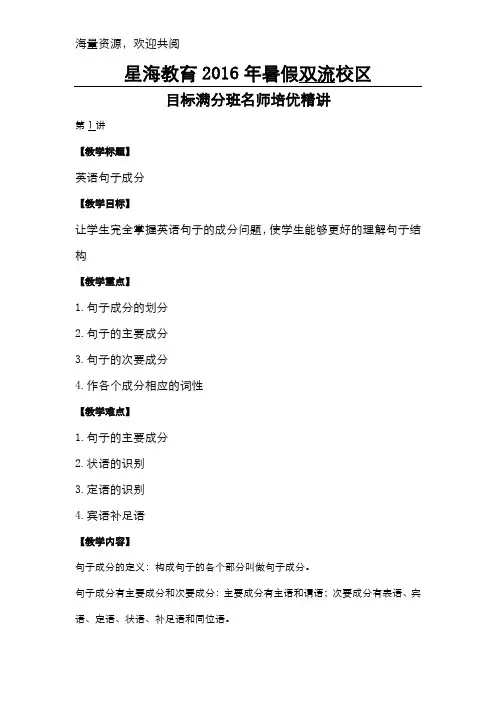
星海教育2016年暑假双流校区目标满分班名师培优精讲第1讲【教学标题】英语句子成分【教学目标】让学生完全掌握英语句子的成分问题,使学生能够更好的理解句子结构【教学重点】1.句子成分的划分2.句子的主要成分3.句子的次要成分4.作各个成分相应的词性【教学难点】1.句子的主要成分2.状语的识别3.定语的识别4.宾语补足语【教学内容】句子成分的定义:构成句子的各个部分叫做句子成分。
句子成分有主要成分和次要成分:主要成分有主语和谓语;次要成分有表语、宾语、定语、状语、补足语和同位语。
A.主语:主语是一个句子所叙述的主体,一般位于句首。
但在therebe结构、疑问句(当主语不疑问词时)和倒装句中,主语位于谓语、助动词或情态动词后面。
主语可由名词、代词、数词、不定式、动名词、名词化的形容词和主语从句等表示。
一句话语法:主语由名词性的词来充当.例如:Duringthe1990s,Americancountrymusichasbecomemoreandmore popular.(名词)ThestudentsalllovetheirEnglishteacher.WeoftenspeakEnglishinclass.(代词)Theygotoschoolbybus.One-thirdofthestudentsinthisclassaregirls.(数词)Toswimintheriverisagreatpleasure.(不定式)Toseeistobelieve.Smokingdoesharmtothehealth.(动名词)WatchingTVtoomuchisbadforyoureyes.It’snouseregrettingit.Therichshouldhelpthepoor.(名词化的形容词)WhenwearegoingtohaveanEnglishtesthasnotbeendecided.(主语从句)Itisnecessarytomasteraforeignlanguage.(it作形式主语,真正的主语为后面的不定式)2B.谓语:谓语说明主语所做的动作或具有的特征和状态。

《新目标英语》九年级Unit 12教学设计设计的基本理念:根据新课标,培养学生自主、合作、探究精神、突出语言运用能力培养的理念而设计。
一、教材分析1.教学内容1)词汇: get, gotten, oversleep, realize, in the shower, by the time2)语言结构:The Past Perfect TenseBy the time / When + Clause, … had already done…2.教材的地位及其作用本单元Topic “Bad days”,要求学生学会用“By the time/when+从句,I had already done sth”对过去发生的动作进行叙述,运用对话、练习等方式,根据动作、故事发生的先后顺序表达,使学生学习并掌握过去完成时态的结构和用法;在进行语言实践的同时,既有难忘尴尬的经历又有幽默风趣的故事,这些和学生的生活都有密切联系,容易引起共鸣,进一步让学生体会人生中有很多事情是值得回忆的;通过了解西方愚人节发生的故事,渗透西方文化。
二、学生分析根据学生现有的能力、学生学习的兴趣,激发学生学习的积极性。
鼓励学生在课堂上大胆地开口说,让每一位学生参与到学习中,提高学生运用语言的综合能力。
三、教学目标《课程标准》中说:英语教学的目的是培养学生运用语言进行交际的能力,为用而学、在用中学、学了就用,因此我把本课的教学目标定为以下几个方面:1.知识目标1)词汇: get, gotten, oversleep, realize, in the shower, by the time2)句型:The Past Perfect TenseBy the time / When + Clause, … had already done…2.技能目标1)利用所学的语言目标,听懂听力内容,并能完成相应的练习。
2)能正确运用本单元中的关键词语、词组。
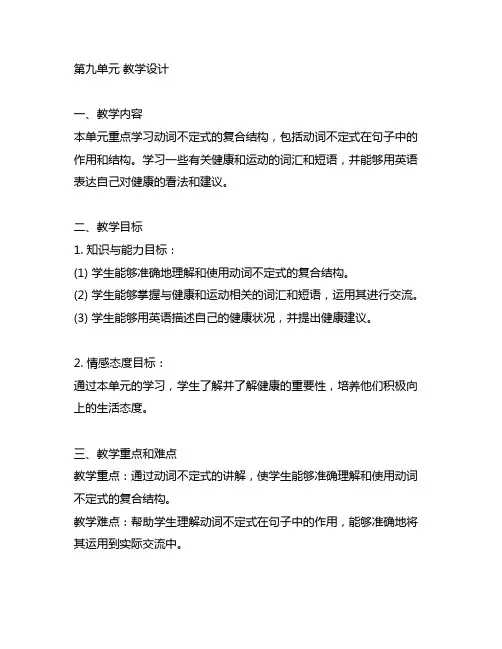
第九单元教学设计一、教学内容本单元重点学习动词不定式的复合结构,包括动词不定式在句子中的作用和结构。
学习一些有关健康和运动的词汇和短语,并能够用英语表达自己对健康的看法和建议。
二、教学目标1. 知识与能力目标:(1) 学生能够准确地理解和使用动词不定式的复合结构。
(2) 学生能够掌握与健康和运动相关的词汇和短语,运用其进行交流。
(3) 学生能够用英语描述自己的健康状况,并提出健康建议。
2. 情感态度目标:通过本单元的学习,学生了解并了解健康的重要性,培养他们积极向上的生活态度。
三、教学重点和难点教学重点:通过动词不定式的讲解,使学生能够准确理解和使用动词不定式的复合结构。
教学难点:帮助学生理解动词不定式在句子中的作用,能够准确地将其运用到实际交流中。
四、教学准备教学素材:教科书、黑板、多媒体设备教学手段:课件、PPT教学环境:教室五、教学过程第一课时1. 调研导入(5分钟)通过幻灯片展示一些与健康相关的图片,引导学生思考健康的重要性,并引发他们对健康话题的兴趣。
2. 学习新知(20分钟)(1) 引导学生听读课文,理解并掌握动词不定式的结构和用法。
(2) 结合课文中的例句,讲解动词不定式在句子中的作用,并举例说明。
3. 合作学习(15分钟)将学生分成小组,让他们就课文中的习题进行合作讨论,加深对动词不定式的理解和掌握。
4. 拓展延伸(10分钟)引导学生根据所学内容,讨论健康与运动的重要性,并可以进行小组展示,让学生表达自己的看法和建议。
第二课时1. 复习巩固(10分钟)通过口头问答、填空练习等方式,复习上节课所学内容,巩固动词不定式的知识点。
2. 操作演练(15分钟)让学生运用所学内容进行对话练习,在教师的引导下,学生可以结合所学内容,进行口语对话练习。
3. 角色扮演(20分钟)设计一些健康场景,让学生分角色进行表演,展示对健康的态度和健康建议。
4. 引导总结(10分钟)教师对学生的表现进行总结评价,并引导学生对本节课的学习进行总结,巩固所学知识点。
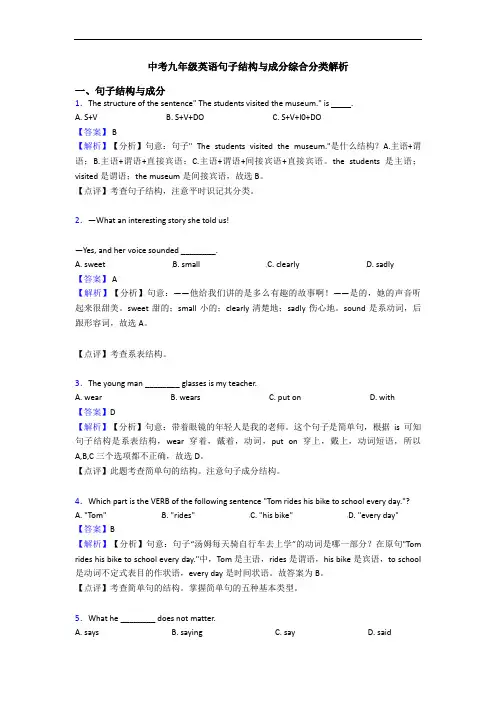
中考九年级英语句子结构与成分综合分类解析一、句子结构与成分1.The structure of the sentence" The students visited the museum." is .A. S+VB. S+V+DOC. S+V+I0+DO【答案】 B【解析】【分析】句意:句子" The students visited the museum."是什么结构?A.主语+谓语;B.主语+谓语+直接宾语;C.主语+谓语+间接宾语+直接宾语。
the students是主语;visited是谓语;the museum是间接宾语,故选B。
【点评】考查句子结构,注意平时识记其分类。
2.—What an interesting story she told us!—Yes, and her voice sounded ________.A. sweetB. smallC. clearlyD. sadly【答案】 A【解析】【分析】句意:——他给我们讲的是多么有趣的故事啊!——是的,她的声音听起来很甜美。
sweet甜的;small小的;clearly清楚地;sadly伤心地。
sound是系动词,后跟形容词,故选A。
【点评】考查系表结构。
3.The young man ________ glasses is my teacher.A. wearB. wearsC. put onD. with【答案】D【解析】【分析】句意:带着眼镜的年轻人是我的老师。
这个句子是简单句,根据is可知句子结构是系表结构,wear穿着,戴着,动词,put on穿上,戴上,动词短语,所以A,B,C三个选项都不正确,故选D。
【点评】此题考查简单句的结构。
注意句子成分结构。
4.Which part is the VERB of the following sentence "Tom rides his bike to school every day."?A. "Tom"B. "rides"C. "his bike"D. "every day"【答案】B【解析】【分析】句意:句子“汤姆每天骑自行车去上学”的动词是哪一部分?在原句"Tom rides his bike to school every day."中,Tom是主语,rides是谓语,his bike是宾语,to school是动词不定式表目的作状语,every day是时间状语。

状语:修饰动词、副词、形容词甚至整句,说明谓语动作发生的时间、地点、方式、伴随状况、目的等等。
如:他在灯下看书。
“在灯下”是状语。
补语:补充说明主语或宾语的成份,补充说明主语的叫主语补足语,补充宾语叫宾语补足语。
如:他把我逗笑了。
He made me laugh.主语:he;谓语:made;宾语:me;宾补:laugh.补语和它补充说明的成份之间有逻辑上的主谓关系,这可以把它和其它成份区分开。
如:上句宾语me和宾补laugh之间,laugh的动作是me来做的。
这就是一种逻辑上的主谓关系。
把这两部分单拿出来可以成一句完整的话,即I laughed.宾补:对宾语的补充,全称为宾语补足语。
We elected him monitor. (名词)We all think it a pity that she did n’t come here.(名)We will make them happy.(形容词)We found nobody in. (副词)Please make yourself at home.介词短语)Don’t let him do that.(省to不定式)His father advised him to teach the lazy boy a lesson.(带to不定式)Don’t keep the lights burning.(现在分词)I’ll have my bike repaired.(过去分词)三、Consolidation1. 句子结构练习:主谓结构(主语+不及物动词)1你应当努力学习。
2她昨天回家很晚。
3那天早上我们谈了很多。
4会议将持续两个小时。
主谓宾结构(主语+及物动词+宾语)1昨晚我写了一封信。
2今天下午我想同你谈谈。
3这本书他读过多次了。
4他们成功地完成了计划。
主系表结构(主语+系动词+表语)1我的兄弟都是大学生。
2冬季白天短,夜晚长。
3布朗夫人看起来很健康。
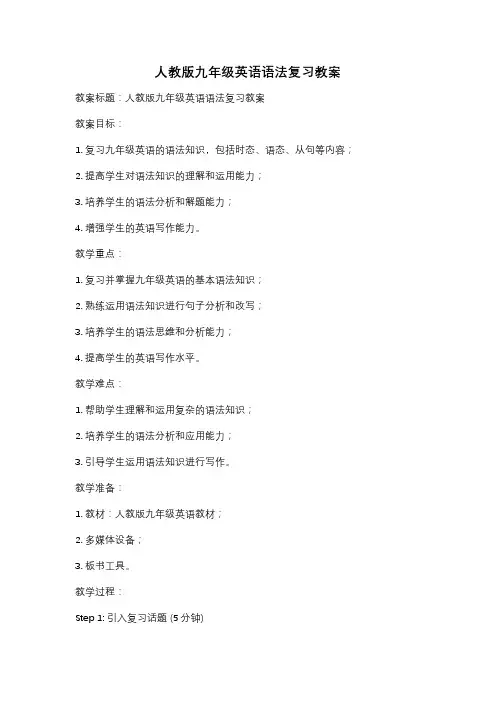
人教版九年级英语语法复习教案教案标题:人教版九年级英语语法复习教案教案目标:1. 复习九年级英语的语法知识,包括时态、语态、从句等内容;2. 提高学生对语法知识的理解和运用能力;3. 培养学生的语法分析和解题能力;4. 增强学生的英语写作能力。
教学重点:1. 复习并掌握九年级英语的基本语法知识;2. 熟练运用语法知识进行句子分析和改写;3. 培养学生的语法思维和分析能力;4. 提高学生的英语写作水平。
教学难点:1. 帮助学生理解和运用复杂的语法知识;2. 培养学生的语法分析和应用能力;3. 引导学生运用语法知识进行写作。
教学准备:1. 教材:人教版九年级英语教材;2. 多媒体设备;3. 板书工具。
教学过程:Step 1: 引入复习话题 (5分钟)通过展示一些与语法相关的图片,引起学生对语法复习的兴趣,并简单介绍本节课的内容和目标。
Step 2: 复习基本语法知识 (15分钟)2.1 复习时态:通过多媒体设备展示不同时态的例句,让学生回忆并说出对应的时态形式。
2.2 复习语态:通过多媒体设备展示被动语态的例句,让学生回忆并说出句子的主动语态形式。
2.3 复习从句:通过多媒体设备展示不同类型的从句,让学生回忆并说出从句的类型和功能。
Step 3: 语法分析和改写练习 (20分钟)3.1 分析句子:给学生发放一些句子,要求他们分析句子的结构和语法成分,并找出句子中的主语、谓语、宾语等。
3.2 改写句子:给学生一些句子,要求他们根据语法要求进行句子的改写,例如改变时态、改写为被动语态等。
Step 4: 语法应用和写作练习 (20分钟)4.1 语法应用:给学生一些句子,要求他们根据语法要求完成句子,例如填入适当的时态、语态或从句等。
4.2 写作练习:给学生一个写作任务,要求他们运用所学的语法知识写一篇短文或对话。
Step 5: 总结和反馈 (10分钟)总结本节课的重点内容和学习收获,并对学生进行语法知识的小测验,以检查他们的掌握情况。
人教版九年级英语全册教案4篇人教版九年级英语全册教案篇1一、教学目标:1. 语言知识目标:1) 学习掌握下列词汇:France, no matter,local, brand, avoid, product,handbag,mobile, everyday2)阅读短文,能按要求找到相应的信息。
3)通过阅读提高学生们的阅读能力。
4) 了解“中国制造”已在世界各国广泛存在,并被世界人民所认可。
2. 情感态度价值观目标:通过阅读短文,让学生们明白中国在近代的发展状况,认识到我们伟大的中国正在快速崛起,从以前依赖进口国外工业产品,到中国制造,中国已加入工业大国之列。
二、教学重难点1. 教学重点:1) 掌握本部分出现的生词和词组,达到熟练运用的目标。
2) 阅读短文,获得相关的信息。
通过阅读练习,来提高阅读能力。
2. 教学难点:1) 阅读短文,获得相关的信息的能力。
2) 理解并运用所学的词汇及表达方式。
三、教学过程Ⅰ. Revision1. Ask Sstorole-play the conversation in 2d.2. Checkthehomework. Let some Ss tell read their sentences.(1). This ringismade of silver.(2). This kindofpaper is made from wood.(3). What ispaintmade from?(4). Hang Zhouisfamous for tea.(5). As far asIknow, tea plants are grown on the sides of the mountains.Ⅱ. Lead in1. 展示一段伦敦奥运会礼品的视频,让学生了解中国制造已被世界人民所接受。
Then ask Sssomequestions:T: As we know,thereare so many things made in China in England. What about in America andothercountries in the world? Now let’s read the passage of 3a.First, readquickly and find the answer to this question:1) Where did KangJianvisit last year?2) Were theremanythings made in China in the US?3) What twothingsdid Kang Jian want to buy in the US?4) Where weretheymade?Ss read thearticlequickly and try to answer the questions:2. 方法指导:带着问题,然后快速阅读短文,争取在较短的时间内,找到答案。
新目标九年级英语Unit1教案一、教学目标通过本单元的学习,学生能够掌握以下英语知识和技能:1.学习并掌握本单元的重点词汇和短语。
2.能够运用所学的句型和词汇进行基本的英语对话。
3.能够听懂并理解有关学校生活和课程的简单对话和文章。
4.能够正确运用所学的语法知识,进行句子的构建和转换。
二、重点和难点本单元的重点是学习并掌握本单元的重点词汇和短语,以及能够正确运用所学的语法知识。
难点是能够听懂有关学校生活和课程的简单对话和文章。
三、教学准备1.教材:新目标九年级英语教材Unit1。
2.教具:投影仪、音频设备。
四、教学过程Step 1:导入新课通过向学生展示一张图片或提出一个与本单元主题相关的问题来引起学生的兴趣。
例如,可以展示一张学校的图片,然后向学生提问:“How do you like your school?” 学生可以就这个问题进行小组讨论。
Step 2:学习词汇和短语通过播放录音和展示词汇图片的方式教授本单元的重点词汇和短语。
老师可以先逐个朗读单词和短语,然后引导学生跟读。
接着,老师可以播放录音,让学生通过听音标出所学的词汇和短语。
Step 3:听力训练播放录音,让学生听一个短对话,并回答与对话内容相关的问题。
然后,老师可以和学生一起核对答案。
接下来,再播放录音,让学生听一篇短文,并回答一些与短文内容相关的问题。
Step 4:口语训练让学生分组进行对话练习。
老师可以给每个小组一个话题,然后让他们用英语进行对话。
例如,可以让学生用英语描述一个他们喜欢的老师或课程。
Step 5:语法讲解通过示范和解释的方式教授所学的语法知识点。
例如,可以讲解现在进行时的构造和用法。
教师可以先给学生一些例句,然后解释句子的结构和含义。
Step 6:语法练习给学生一些练习题,让他们运用所学的语法知识进行句子的构建和转换。
例如,可以让学生根据给定的动词和人称代词,完成句子的构建和转换。
Step 7:阅读训练让学生阅读一篇有关学校生活和课程的短文,并回答问题。
九年级英语句子结构与成分经典例题一、句子结构与成分1.Which structure is right?A. Your father is ill in bed.(S+V)B. Your friend fell down.(S+V+O)C. Your team won the match.(S+V+O+OC)D. He seems ill.(S+V+P)【答案】 D【解析】【分析】句意:哪个结构是正确的? A is 是系动词,故是主系表结构形式,S+V 表示主谓,B fell 是不及物动词,故是主谓形式,S+V+O 表示主谓宾,C the match是宾语,故是主谓宾形式,S+V+O+O表示主谓双宾,Dseem是系动词,故是主系表形式, S+V+P 表示主系表,故选D。
【点评】考查句子结构,注意seem是系动词的用法。
2.Which of the following sentences is correct?A. He came in and sat down.B. We all like <Harry Potter>.C. When we met. He didn't say hello.D. We went out, headed for the bus stop.【答案】 A【解析】【分析】句意:下面那个句子是正确的。
A是简单句,came和sat是并列谓语,都是一般过去式,所以A正确。
B中的符号不符合英语习惯,在英语中没有书名号,表示书名时通常用斜体字形式。
C句的标点符号是错误的,把met后的句号改为逗号才符合复合句的定义。
D句中headed前应加上and或者将headed改为heading构成伴随状语。
因此选A。
【点评】考查句法知识。
3.—What an interesting story she told us!—Yes, and her voice sounded ________.A. sweetB. smallC. clearlyD. sadly【答案】 A【解析】【分析】句意:——他给我们讲的是多么有趣的故事啊!——是的,她的声音听起来很甜美。
九年级英语上册第一单元教案设计教学目标1.学习并掌握本单元的主要词汇和短语。
2.学习并运用基础的语法知识,如一般现在时。
3.培养学生的听、说、读、写能力。
4.提高学生的综合语言运用能力。
教学重点1.掌握本单元的主要词汇和短语。
2.能够运用一般现在时描述自己的日常活动。
3.能够用简单的句子进行自我介绍。
教学准备1.教材:九年级英语上册教材第一单元。
2.多媒体设备。
3.教学课件。
4.单词卡片和图片等教具。
教学过程Step 1: 情境引入(5分钟)•利用多媒体设备和图片展示一些人物和日常活动的图片,引起学生的兴趣和好奇心。
•提问学生:“你们在日常生活中都做哪些活动?”•引导学生讨论并复习一些相关的动词。
Step 2: 学习新词汇(10分钟)•呈现并教授本单元的重点词汇和短语。
•使用图片、动作和例句等多种方式帮助学生理解和记忆词汇。
Step 3: 学习语法知识(15分钟)•教授一般现在时的用法和句型。
•呈现并解析一般现在时的肯定句、否定句和疑问句的结构。
•通过练习和对话让学生熟悉并掌握一般现在时的用法。
Step 4: 听力训练(15分钟)•播放一段关于日常生活的对话录音。
•要求学生根据所听到的信息选择正确的图片或回答相关问题。
Step 5: 口语练习(15分钟)•学生进行小组活动。
每个小组选择一位代表扮演自己进行自我介绍。
•其他小组成员记住自己小组成员的介绍内容,并向其他小组进行转述介绍。
Step 6: 阅读训练(15分钟)•学生独立阅读一篇关于日常活动的短文。
•学生回答与短文内容相关的问题,检测阅读理解能力。
Step 7: 写作练习(10分钟)•学生按照自己的日常活动,用一般现在时写一篇短文。
•提醒学生注意句子结构和语法正确性。
Step 8: 总结和反思(5分钟)•与学生一起回顾本节课学到的内容,并进行总结归纳。
•鼓励学生主动反思自己的学习情况,并提供必要的帮助和指导。
课后作业1.完成课堂上未完成的练习题。
人教版中考英语九年级英语句子结构与成分考点解析(Word版附答案)一、句子结构与成分1.You may know all the words on the right, but which of the following carries meaning?A. A friend self is a second.B. A second is self a friend.C. A friend is a second self.D. Self a second is a friend.【答案】 C【解析】【分析】句意:你可能知道右面所有的单词,但是下列哪个句子是有意义的?second,第二个;friend,朋友;self,你自己;a,不定冠词表示数量一;C为正确选项,意为:朋友是另一个自己。
故选C。
【点评】考查连词成句。
先确定句意,根据语法知识将词连接成句。
2.—What an interesting story she told us!—Yes, and her voice sounded ________.A. sweetB. smallC. clearlyD. sadly【答案】 A【解析】【分析】句意:——他给我们讲的是多么有趣的故事啊!——是的,她的声音听起来很甜美。
sweet甜的;small小的;clearly清楚地;sadly伤心地。
sound是系动词,后跟形容词,故选A。
【点评】考查系表结构。
3.This cake is really big. _______ share it.A. May be we canB. We may be canC. Maybe we canD. Maybe can we 【答案】C【解析】【分析】句意“蛋糕真的很大,也许我们可以分享它”。
maybe为副词,也许,可能,放于句首。
may be中may是情态动词,be是动词原形,为系表结构,译为“也许是,可能是”。
Module 2 Public holidaysUnit 3 Language in use设计说明教学反思本单元主要复习时间状语从句。
通过观察句子,分析句子的结构和意义,归纳各种时间状语从句的用法。
并通过选词或选句填空,提高学生对单词、短语、句型、语法等知识的实际运用能力。
然后通过听录音、问答、写作训练,让学生动脑、动耳、动口、动手,巩固时间状语从句的用法,运用与节日相关的知识。
教学目标通过本单元的教学,让学生达成以下目标:1. 知识目标(1)复习本模块的重点单词、短语及句型。
(2)复习时间状语从句。
2. 能力目标(1)能够运用时间状语从句知识完成各种练习。
(2)能够问答与节日相关的问题。
3. 情感目标通过学习节日的相关知识,了解更多传统习俗和风土人情。
重点难点重点:本模块的重点单词、短语和句子难点:时间状语从句的用法教学准备PPT课件;教材录音等授课时数1课时教学过程Step 1Lead-inLanguage practiceWhile we’re staying with our friends, we’re going to spend one day in Qingdao.Before we begin dinner, my father gives thanks for the food.When it is all over, everyone helps wash the dishes.And my family always go somewhere interesting as soon as the holiday begins.We have celebrated the festival since the first pioneers from England arrived inAmerica.After they landed, their first winter was worse than any English winter.Step 2 Grammar时间状语从句一、什么是时间状语从句一个句子在另一个句子中充当时间状语,那么这个句子就叫做时间状语从句,另一个句子叫做主句。
句子的结构九年级英语教案句子的结构英语的句子,与汉语句子类似,按照语法结构也可分为三类,即简单句,并列句和复合句。
那么有关这三种句型的详细信息,请看下面的讲解。
一、简单句简单句只包含一个主谓结构,并且各个结构都是由单词或短语组成,不包含任何从句。
简单句有五种基本句型。
1.主语+谓语(不及物动词)The new term begins.新学期开始了。
2.主语+谓语(及物动词)+宾语The girl is learning to play the piano.这个女孩在学弹钢琴。
3.主语+连系动词+表语Susan is a student.苏珊是个学生。
4.主语+谓语(及物动词)+间接宾语+直接宾语He bought her a watch.他给她买了一块表。
5. 主语+谓语(及物动词)+宾语+宾语补语We all be lived you honest.我们都认为你是诚实的。
二、并列句(简单句+连词+简单句)并列句是由两个或多个简单句连接而成的。
其中的各个简单句并列平行,同等重要,相互之间没有从属关系,能够独立成句。
它们之间要用连词连接。
并列句可分为四种:1.表示相同关系用连词或逗号、分号连接构成并列句。
常用连词有:and, not only...but also..., neither...nor...Her father is a teacher and her mother is a doctor.她的父亲是老师,母亲是医生。
Susan not only runs fast, but also jumps high.苏姗不但跑得快,而且跳得高。
I could neither swim nor skate.我既不会游泳,也不会滑冰。
I wouldn't see this film , it's boring.我不想看这个电影,它令人心烦。
2.表示转折关系常用连词有:but, still, yet, while, when等。
It was late at night, but he went on doing his homework. 夜已深了,但是他还在继续做作业。
She was busy cooking while they were watching TV.她忙着做饭,而他们却在看电视。
The film is not perfect, still, it's good.这部影片虽然不是无可挑剔,但还是好的。
3.表示选择关系常用连词为:or, either...or...。
Would you have tea or coffee?你是喝茶还是咖啡?The teacher wanted to see either his father or mother.老师要见一下他的父亲或是母亲。
Either this road or that on e can lead you to that hospital.这条路或那条路都通往那家医院。
4.表示因果关系常用连词有for和so。
She soon fell asleep, for she was too tired.她很快就睡着了,因为她太累了。
We hurried to the railway station, for there was little time for the train to leave. 我们急忙赶往车站,因为火车很快就要开了。
It was raining harder and harder, so we had to stay at home.雨下得越来越大,所以我们只得呆在家里。
The teacher asked Susan to go, so she went.老师让苏姗到她那去,因此她就去了。
三、复合句(主句+连词+从句)包含一个主句,一个或一个以上的从句的句子叫复合句。
从句从属于主句并充当主句的某一成分,如主语,表语,宾语,定语,状语等。
1.主语从句主语从句就是从句作主语。
它可作谓语动词的主语,也可作分词的主语。
主语从句有三种:(1)由that引导:It is impolite that you talked so loud in the restaurant.你们在餐馆那么大声音说话是极不礼貌的。
It is a great surprise that she won the champion.她得了冠军,真是令人惊异。
(2)由what, whatever和whoever等代词引导:What she said just now is correct.她刚才说的话很对。
What caused the air disaster is under the investigation.究竟是什么导致了这次空难,正在调查。
Whatever you have seen must be kept in your mind.不管你看到什么,都要记在心里。
Whoever breaks the world record will get one million yuan as an a ward. 任何打破世界纪录的人将得到一百万元奖金。
(3)由连接副词whether, how, when, why, where引导:When the sports meet will be held isn't decided.什么时候开运动会还没有定下来。
Whether she can pass the exam is not sure.她是否能够通过考试还没有把握。
How he arrived there is unknown to anybody.他是如何到达那里的,没有人知道。
Why the fire broke out here in the workshop remains a mystery.车间这里为什么会发生火灾仍是个谜。
注意:当主语从句过长而谓语较短时,通常用代词it作形式主语,而把从句放在句尾。
It remains a mystery that the air disaster took place that day.那天发生的空难仍然是个谜。
It is uncertain whether we'll attend the meeting or not .我们是否参加那个会议还没有确定。
2.宾语从句这类从句常是这种结构:主句+引导句+从句,从句中始终用陈述语序。
(1)由that引导(通常that可以省略)She is very sure that she can work out the problem.她确信她能解出这道题。
She told me that she could finish it herself.她跟我说她可以自己完成这件工作。
(2)由what, who, which等关系代词引导We don't understand what you said just now.我们不明白你刚才说的话。
Tell me which you want?告诉我你要哪一个?Do you know who is the man over there?你知道那边那个人是谁吗?(3)由how, when, why, where引导宾语从句They wanted to know when the building would be set up.他们想要知道这座楼房何时建成。
Will you please tell me how I can get to the park?请告诉我怎么走才能到公园好吗?I wonder where she is now.我想知道她现在在哪儿?I don't know why you dislike physics.我不知道为什么你讨厌物理。
(4)一些形容词之后所接的句子也是宾语从句。
这些形容词有:glad, sorry, sure , afraid, worried, angry, aware, confident等。
I'm glad that you've helped me a lot.很高兴你给我这么大的帮助。
We are confident that we can beat them.我们有信心打败他们。
The father was angry that his son failed to pass the maths exam.这位父亲对他的儿子数学不及格很恼火。
I'm not sure if she has finished the painting.我不清楚她是否完成了那幅作品。
注意:当宾语从句过长时,可用it作形式宾语而将从句放在句子后面。
She thought it pity that I had missed the chance.她认为我错过了那个机会非常可惜。
I found it very easy that I worked out the problem .我觉得很容易地就做出了这道难题。
The manager made it clear that your idea was impossible .经理已明白地指出你的想法不能实现。
3.定语从句以从句的形式修饰或限定主句中的名词、代词、短语等的句子,叫作定语从句。
定语从句通常用关系词(关系代词和关系副词)把它与主句连接起来。
它在句中所修饰和限定的>词或短语称为先行词。
引导定语从句的关系代词有:who(指人,在从句中作主语或宾语),whom(指人,作宾语) ,whose(指人,作定语),that(可指人或物),which(指物)。
引导定语从句的关系副词有:when(指时间),where(指地点),why(指原因)。
这些关系副词相当于(介词+which)。
例如:when=in(on,at,during)+whichwhere=in(at,to)+whichwhy=for which(1)关系代词在从句中作主语、表语、宾语或定语;关系副词在从句中作状语。
作主语:The woman who is talking to the teacher is her mother.正在跟老师说话的那个女人是她的母亲。
The boy who played the piano on the stage yesterday is Mr. Li's s on.昨天在台上弹钢琴的那个男孩儿是李先生的儿子。
作定语:Chaplin was a great actor whose name is well known all over the world.卓别林是一位闻名于全世界的伟大的演员。